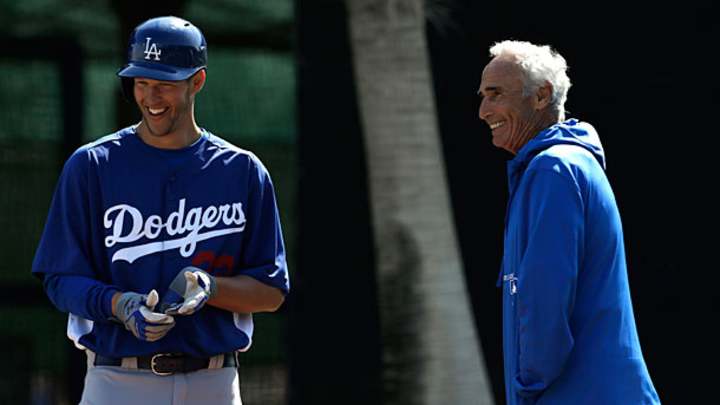Is Clayton Kershaw better right now than Sandy Koufax? No (not yet). More valuable? Yes

Clayton Kershaw and Sandy Koufax have combined to win five Cy Young awards. (Paul Sancya/AP)

Forty-seven years ago today, on Nov. 18, 1966, Sandy Koufax announced his retirement from baseball due to chronic arthritis in his left elbow. It was a shocking decision given that Koufax had been the most dominant pitcher in baseball over the previous four seasons. From 1963 to '66, he had averaged a 24-7 record, 307 strikeouts and a 1.86 ERA, winning three out of four Cy Young awards at a time before each league had its own award. That brief run as the best pitcher in baseball, plus the two All-Star seasons that preceded it and his dominance in four World Series (0.95 ERA, four complete games, two shutouts in seven starts and one scoreless relief appearance) made him a Hall of Famer in his first year of eligibility and a permanent part of any discussion about the greatest pitcher of all time.
There is now another Dodgers lefty who is at the forefront of any discussion about the greatest pitchers in the game today. That man is Clayton Kershaw, who last week won his second NL Cy Young award in the past three seasons (he finished second in 2012). Koufax, for all his incredible accomplishments, never once posted a park- and league-adjusted ERA+ as high as Kershaw's 194 this past season (Koufax's best mark was 190 in his final season). In addition, the first of Koufax's Cy Young awards didn't come until his age-27 season, whereas Kershaw has won two before the age of 26. Kershaw still has a long way to go, of course, but he has accomplished so much so soon that there is a very real possibility that he could one-day do the unthinkable: surpass Koufax as the greatest lefthanded pitcher in Dodgers history.
Of course, for that to happen, Los Angeles has to pay big money to keep him around. Kershaw is due to be a free agent after the 2014 season, making this offseason the Dodgers' last best chance to sign him to an extension before he hits the market. In some ways, that puts Kershaw in the same position this winter that Koufax was in when he and fellow L.A. ace Don Drysdale staged a joint holdout during spring training of 1966.
At the time of the holdout, Koufax, like Kershaw now, had won two of the last three Cy Young awards (Koufax was third across both leagues in his "off" year of 1964). Koufax had led the NL in ERA each of the last four seasons and the majors in strikeouts in his two Cy Young years. Kershaw has led the majors in ERA each of the last three seasons and the NL in strikeouts in his two Cy Young campaigns. Both were undeniably the best pitcher in baseball when they entered their negotiations with the Dodgers.
That's where the similarities end, however. One can't compare the two situations financially. Koufax's holdout came a decade before real free agency. His $110,000 salary in 1965 was already among the highest in the game, and the two-year, $260,000 contract Willie Mays signed that February was the richest in baseball history. Without the threat of actual free agency, Koufax, who was seeking a three-year joint contract with Drysdale worth a total of more than $1 million, wound up settling for one-year at $125,000. Kershaw, meanwhile, is coming off a two-year, $19 million deal, and seems sure to land the richest pitching contract ever, surpassing the $180 million, seven-year extension that Justin Verlander signed with the Tigers in March. In fact, Kershaw stands an excellent chance of becoming the first pitcher to sign a contract that exceeds $200 million in total value.
There is often speculation about how much pre-free-agency players would be worth in today's game, and while the situations of Koufax and Kershaw aren't exactly the same and there are several variables at play, it's worth exploring which player would get the longer and richer contract if they had similar circumstances. Let's assume Koufax, at the time of his holdout, was in the same position Kershaw is now: coming off a $19 million contract with free agency looming after the coming season. He would still be a 30-year-old with chronic arm problems whose arthritic pitching elbow had sent him to the disabled list in each of the last two seasons and which required cortisone shots and painkillers just so he could take the mound.
What would that version of Koufax have been worth on today's market? It's an interesting question, one clouded significantly by the condition of his elbow, a condition that was common knowledge at the time. As Jane Leavy wrote in her acclaimed biography of Koufax in 2002: Sandy Koufax: A Lefty's Legacy, "back issues of sports magazines and deadline newspaper stories from 1964 on reveal endless speculation over how long and how effectively he could pitch."
Put a 30-year-old Koufax with that arthritic elbow in Kershaw's place this winter and there very well may have been no pressure for the Dodgers to extend him at all, and if they did, they may well have only bought out his first free agent year. Coming off that presumed two-year, $19 million contract, his second Cy Young award, a record 382 strikeouts and a pair of 10-strikeout shutouts in a victorious World Series, Koufax would be due for a big payday in his final arbitration year despite the elbow. Because of it, however, his hopes for an extension might have been limited to a two-year-deal in excess of $40 million. That's nearly identical to the one two-time Cy Young winner Tim Lincecum signed with the Giants in January 2012 heading into his age-28 season, before he stopped being effective.
